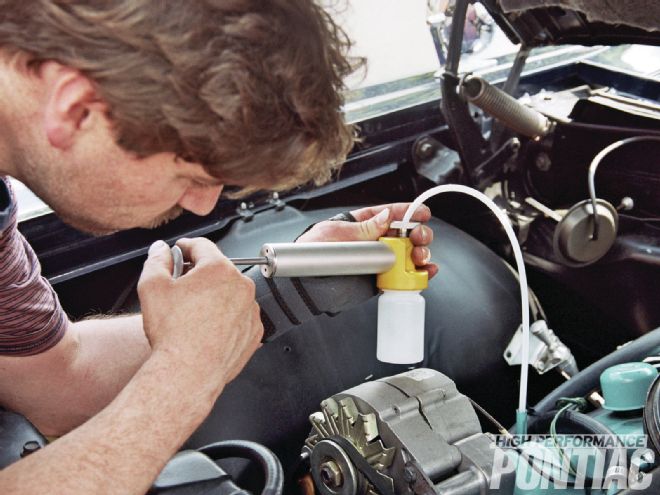
There are a number of different fluids employed in every Pontiac. These can be classified as working fluids like that in the hydraulic braking system, or lubricating fluids such as engine oil, or a combination of both. In an automatic transmission, the fluid is both a worker and a lubricant, since hydraulic pressure and flow are part of the fundamental design of a self-shifting gearbox.
It needs to be recognized that no fluid (working or lubricating) has an unlimited service life. The chemistry of these fluids is very complex, and over time the components wear out, become diluted with moisture through absorption, and are contaminated by the surfaces they contact. Numerous heat cycles on a vehicle that is used year-round takes its toll on the fluid’s ability to perform its designed task.
1 Any Pontiac engine can look great on the outside, but through fluid analysis you can learn if it’s healthy on the inside. This SD-455 Formula is freshly restored and its engine freshly rebuilt, so it does not have any issues, yet it makes great eye-candy for some mock-up photos of the remainder of the oil-extraction process. ">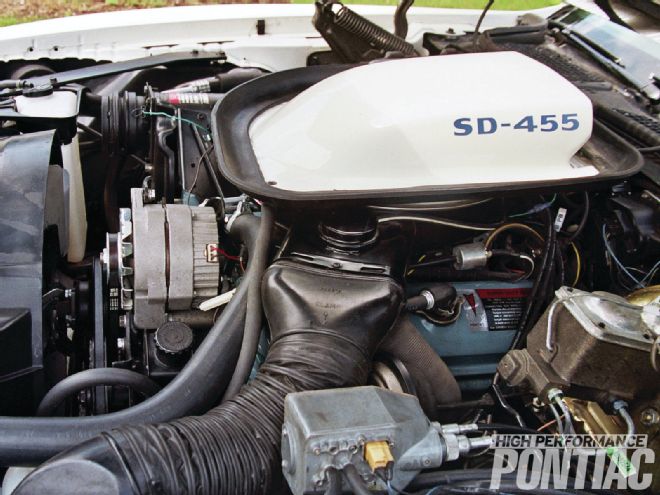 <strong>1</strong> Any Pontiac engine can look great on the outside, but through fluid analysis you can learn if it’s healthy on the inside. This SD-455 Formula is freshly restored and its engine freshly rebuilt, so it does not have any issues, yet it makes great eye-candy for some mock-up photos of the remainder of the oil-extraction process.
<strong>1</strong> Any Pontiac engine can look great on the outside, but through fluid analysis you can learn if it’s healthy on the inside. This SD-455 Formula is freshly restored and its engine freshly rebuilt, so it does not have any issues, yet it makes great eye-candy for some mock-up photos of the remainder of the oil-extraction process.
Pontiac deemed service with the proper fluid is a sure way of maintaining your vehicle, but through spectrum analysis of the used fluid, a wealth of information can be gleaned. Think of it as a blood test for a Pontiac. Fluid analysis allows you to confirm the condition of the component, the track wear, and catch a problem before it becomes a major issue. Best of all, fluid analysis is a cost-effective means to not only build a history on your Pontiac, but it can be considered a forensic investigation of an engine or component that you are considering buying.
A small sample sent to a test laboratory will tell you the true story about the component -- the only caveat being that the fluid must have seen some use before testing for it to be accurate. If the seller changed the fluid and did not run the engine or car long enough, it is akin to checking the fluid right from the bottle.
The best method to obtain a sample is through an application-specific extraction pump, as seen in this story ($45). This is non-invasive and allows in-service samples to be checked without violating the system in question. If you are checking the fluid on your own Pontiac -- for example, the engine oil -- it can be done when it is being changed. Simply follow your normal drain procedure, letting the oil run from the pan for a few seconds so that the dirt from the drain plug is not captured, and fill the clean bottle supplied by the test lab. Seal it up and send it out.
5 The pump comes with enough flexible tubing for many samples. Loosen the thumbscrew and feed the flex tubing into the bottle so it can just be seen. Cut the other end to the necessary length to go through the dipstick tube (engine or transmission) or other part you are taking a sample from.">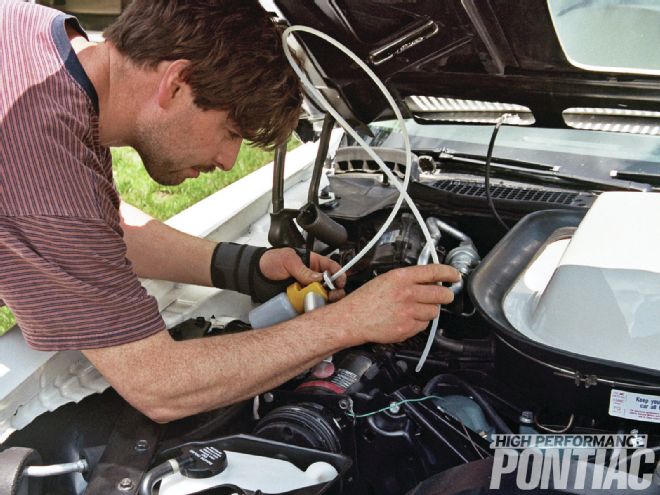 <strong>5</strong> The pump comes with enough flexible tubing for many samples. Loosen the thumbscrew and feed the flex tubing into the bottle so it can just be seen. Cut the other end to the necessary length to go through the dipstick tube (engine or transmission) or other part you are taking a sample from.
<strong>5</strong> The pump comes with enough flexible tubing for many samples. Loosen the thumbscrew and feed the flex tubing into the bottle so it can just be seen. Cut the other end to the necessary length to go through the dipstick tube (engine or transmission) or other part you are taking a sample from.
Each test lab will provide application- specific instructions for its service, but generally they are not too different from what is represented here. Engine oil, transmission fluid in either a manual or automatic gearbox, and differential lubricant are the most common areas to check. Some labs like to check the power-steering fluid also, but it is less common.
The actual method to analyze a fluid for foreign material and overall condition is quite complex and employs many different sciences. For this article, HPP worked with On-Site Analysis (OSA) in Sandy, Utah. The company produces a line of accurate analytical equipment and also offers fluid testing as a service to the public. Tests are conducted using infrared spectroscopy and emissions to monitor engine and transmission wear, as well as the physical properties of the fluid and its condition.
6 Feed the plastic tube into the oil pan via the oil dipstick tube, so it touches the fluid."> <strong>6</strong> Feed the plastic tube into the oil pan via the oil dipstick tube, so it touches the fluid.
<strong>6</strong> Feed the plastic tube into the oil pan via the oil dipstick tube, so it touches the fluid.
OSA tests for nine elements -- six wear metals and three contaminant metals, along with other areas. An analysis costs $14.95 and checks 30 different areas. A complete report is provided that includes the amount of contaminants or material found, a glossary of terms, and the corrective action/response required.
HPP will now provide a little background on the history and types of fluids found in a Pontiac to further establish the value of analysis.
Fluid Dynamics
Engine Oil
Engine oil is a common area to analyze and testing can reveal much, especially if you are worried about using newer formulations in an older Pontiac. (We have covered the properties and rating systems for engine oil at length in two previous stories, “The Slippery Truth About Motor Oil” and “Juggling the Truth About Today’s Oil,” both of which can be referenced on www.highperformancepontiac.com, so we won’t delve into those areas in this story.)
For example, if potassium is discovered in the oil, it can be an indication of coolant migration. Silicon is the most common cause of wear, and indicates the presence of dirt or seal material. Other metals identify a problem in the valvetrain or rotating assembly.
Transmission Fluid
The first automatic transmission to resemble what we know today was introduced by General Motors in 1937 as the Oldsmobile Safety Transmission. It employed a simple fluid coupling and semiautomatic gear changing. This was superseded in 1939 by the first fully automatic transmission, the Oldsmobile Hydramatic, using planetary geartrains and manual, and hydraulic controls for the clutches and bands.
Following problems with the earlier units after a recommendation for the use of engine oil as the working fluid, GM Research, which worked closely with Mobil, designed a fluid with better low-temperature characteristics for the new transmission. Buick pioneered the replacement of the simple fluid coupling (which offers no torque multiplication) with a torque converter type in its 1948 Dynaflow, which resulted in a transmission very similar to what our readers are familiar with today.
With the introduction of the torque converter, more heat was generated in the transmission, and an improved type of fluid was required. In 1949, GM issued its Type-A specification for a fluid, which was succeeded by Type A Suffix A in 1957. These were initially the standard specifications for transmission fluids, but Ford in 1960 and Chrysler in 1964 issued their own specifications, while GM again introduced an improved fluid know as Dextron in 1967.
Due to the internal clearances and choice of friction-materials employed by the Detroit manufacturers, in most cases the automatic-transmission fluid is brand-specific. Using the wrong fluid in a transmission can result in poor performance, improper shift characteristics, leaks, and complete failure.
9 The Pontiacs we used for the extraction photos for this story were just restored by Classic Restorations and had little to no mileage on the fluids. Since we didn’t have a poorly maintained Pontiac on hand for the fluid test, we obtained examples from OSA to illustrate the info the company provides when the news isn’t so good, and the recommendations they provide for corrective action. That said, this sample of a high-mileage (390,000-plus miles) car better represents the value of fluid analysis. Yellow boxes indicate higher than normal content for those items.">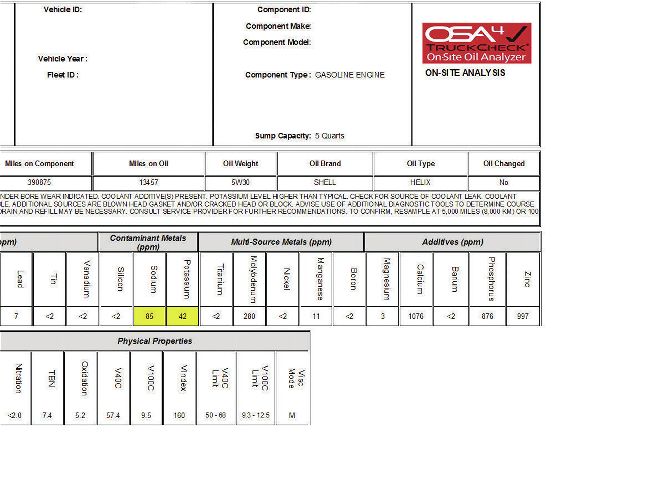 <strong>9</strong> The Pontiacs we used for the extraction photos for this story were just restored by Classic Restorations and had little to no mileage on the fluids. Since we didn’t have a poorly maintained Pontiac on hand for the fluid test, we obtained examples from OSA to illustrate the info the company provides when the news isn’t so good, and the recommendations they provide for corrective action. That said, this sample of a high-mileage (390,000-plus miles) car better represents the value of fluid analysis. Yellow boxes indicate higher than normal content for those items.
<strong>9</strong> The Pontiacs we used for the extraction photos for this story were just restored by Classic Restorations and had little to no mileage on the fluids. Since we didn’t have a poorly maintained Pontiac on hand for the fluid test, we obtained examples from OSA to illustrate the info the company provides when the news isn’t so good, and the recommendations they provide for corrective action. That said, this sample of a high-mileage (390,000-plus miles) car better represents the value of fluid analysis. Yellow boxes indicate higher than normal content for those items.
All automatic-transmission fluids share basic requirements. To overcome the heating and churning action within the transmission casing, oxidation-inhibited and non-foaming oil is essential. To maintain cleanliness within the gearbox, a dispersant is added, and a viscosity modifier prevents excessive thinning of the fluid when it becomes hot.
The fluid must also be compatible with the seals of the transmission and not corrode any of the metallic components. It should also guard against internal corrosion from atmospheric moisture when left standing.
Not only must the fluid not attack the friction surfaces, but it must also provide the correct frictional characteristics as the clutches and bands come into engagement. These required frictional characteristics are specified by the transmission manufacturers and must not change significantly over the life of the fluid. They are evaluated in bench clutch-pack friction tests and in “shift feel” testing on the road.
Through the late ’70s, there was a major difference between the frictional requirements of Ford and those of General Motors and most other manufacturers. Today there are only minor differences between the GM Dextron II, Dextron III, and the latest fluids for GM vehicles.
Make sure the fluid you purchase can be retrofitted to the older transmission in your Pontiac. All major brands of automatic-transmission fluids will list the retrofit capability of their product so it can be used with no worry. Read the label!
Gear Oil
Since the development of the hypoid rear axle (gears working at a right angle) by Packard in the ’20s, there has been major concern over gear oil and the proper formulation. Due to the high degree of sliding between the ring and pinion and the incorporation of spider gears for easy turning, a strong lubricant with good properties is required. These are usually referred to as an EP lubricant for extreme pressure.
Gear oil formulation is a difficult balancing act between the various requirements of the application. Precise formulations are proprietary, and the manufacturing process for individual additives and the purity are highly guarded and make the product brand specific.
A fluid test with OSA may be the best $14.95 you will ever spend on your Pontiac
Gear oil needs to contain anti-oxidants and anti-corrosion additives, cleanliness dispersant, and seal compatibility and anti-foam compounds. If a limited-slip differential is employed, additional friction-control additives are required to prevent chatter and noise.
Gear oil is identified by the American Petroleum Institute (API) designation that begins with the letters GL followed by a hyphen and a number. Though GL-1 to GL-4 are now obsolete, most applications call for GL-5 or better test criteria. In addition there is a viscous weight assigned to the oil, such as 75W-90. Early Pontiac differentials used a 90-weight oil, which was thicker than the commonly produced today multi-viscosity 75W-90 for light-duty vehicles.
When it comes to lubricants, the W stands for Winter (the same holds true for motor oils). Thus a 75W-90 or 80W-90 GL-5 gear lubricant will not thicken as much in the winter (when compared to straight 90-weight) and will offer the viscosity-breakdown protection of a 90-weight when at operating temperature. This is the ideal differential lubricant for our readers with older Pontiacs. The multi-viscosity lubricant will allow for less wear during cold operation than what was employed years back.
Some better brand gear oils already have a limited-slip additive mixed in and will require nothing else. The bottle will identify if it does. These fluids can safely be employed in an “open” rearend or one with no traction-sensing clutches.
10 For the automatic-transmission report, the yellow boxes showing higher levels of aluminum and silicon indicate further investigation is needed regarding the wear of the aluminum and iron parts of the trans and the presence of seal material.">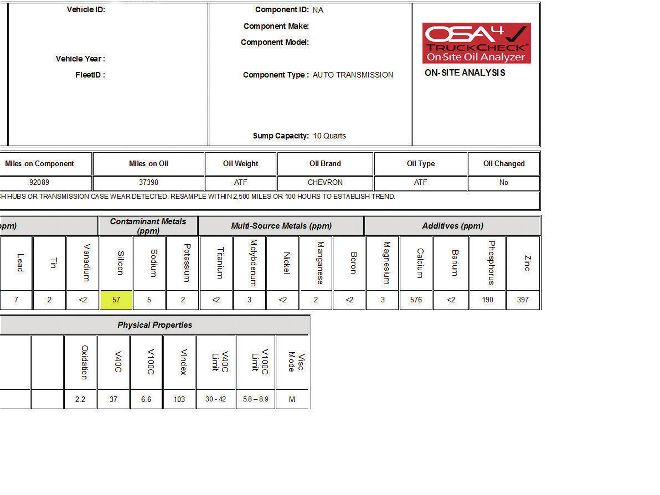 <strong>10</strong> For the automatic-transmission report, the yellow boxes showing higher levels of aluminum and silicon indicate further investigation is needed regarding the wear of the aluminum and iron parts of the trans and the presence of seal material.
<strong>10</strong> For the automatic-transmission report, the yellow boxes showing higher levels of aluminum and silicon indicate further investigation is needed regarding the wear of the aluminum and iron parts of the trans and the presence of seal material.
Myths and Facts
Many manufacturers may claim a “fill-for-life” status on their transmission fluid. That would only be under ideal operating conditions, which few vehicles experience. Short trip cycles with many shifts, high engine-operating temperatures, and wear in the gearbox will all degrade the fluid and are the reasons it should be changed, or at the least analyzed.
In the ’70s, GM claimed the very popular sniff test (removing the dipstick and smelling the transmission fluid) was unreliable. The corporation stated that Dextron and later fluids would take on a brown appearance instead of red and a burnt smell, but will still be functional. GM claimed that if the transmission shifted fine, no service would be required. It seems this statement was more a response to satisfy customer complaints than sound engineering. The only way to actually determine if a fluid is still usable is through chemical analysis.
Since almost every Pontiac automatic transmission has a cooler that is part of the vehicle’s radiator, any problem with the engine’s cooling system will impact the transmission fluid life and operation. An engine that is overheated just once will ruin the transmission fluid. For this reason if your Pontiac ever has a hot-running problem, it is important to service the automatic gearbox after the problem is corrected.
Fluid operating temperature versus life is not linear. Once the fluid reaches near 300 degrees F, its useful life is measured in tens of miles—not tens of thousands. A stuck thermostat in the engine and a mechanic not recognizing its impact on the fluid ruins more automatic transmissions than anything else.
Many old-time mechanics say that if a car has never had the transmission fluid changed, you shouldn’t renew it because the unit will fail afterwards. If the transmission has been neglected and is full of contaminants, the new fluid with its fresh detergents can dislodge some foreign material and cause a potential problem. The thing to remember is that if you don’t change the fluid, the transmission will eventually fail anyway. It’s a rare instance that it is hastened with the new fluid. The important point is you shouldn’t allow the transmission to get to this state.
11 This differential lube report is representative of the information that can be gleaned through analysis. Red boxes require immediate action and yellow boxes are cause for concern and further investigation.">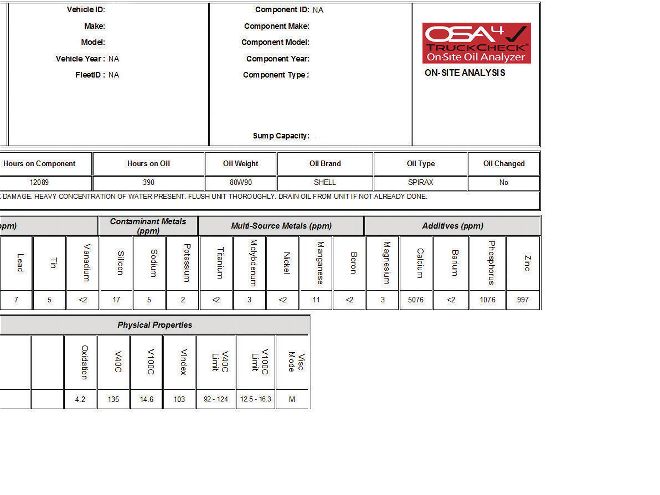 <strong>11</strong> This differential lube report is representative of the information that can be gleaned through analysis. Red boxes require immediate action and yellow boxes are cause for concern and further investigation.
<strong>11</strong> This differential lube report is representative of the information that can be gleaned through analysis. Red boxes require immediate action and yellow boxes are cause for concern and further investigation.
More Considerations
Most, if not all, Pontiacs don’t have a drain plug on the torque converter, so even when dropping the pan to change the fluid, you will not be getting it all out. It will take two or more changes depending on the size of the torque converter to have all fresh fluid in the gearbox. For this reason, you may want to consider an aftermarket transmission pan with a drain plug, or simply drill a hole and weld a drain plug into your OE pan. This way the fluid can be exchanged easily for all new.
Regardless of the fluid being considered, a yearly analysis will prove to be a valuable tool in keeping your Pontiac on the road. As an aside, if the day comes when you need to part company with your Tin Indian, a file of fluid reports over the years could help you command a higher price and remove a good deal of uncertainty from the buyer about the Pontiac’s condition. A fluid test with OSA may be the best $14.95 you will ever spend on your Pontiac.